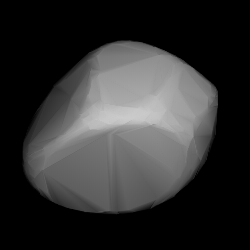 Shape model of Candy from its lightcurve | |
| Discovery [1] | |
|---|---|
| Discovered by | E. Bowell |
| Discovery site | Anderson Mesa Stn. |
| Discovery date | 9 November 1980 |
| Designations | |
| (3015) Candy | |
Named after | Michael P. Candy (British astronomer) [2] |
| 1980 VN ·1974 VL2 1974 XC ·1984 HS | |
| main-belt ·(outer) [1] [3] | |
| Orbital characteristics [1] | |
| Epoch 4 September 2017 (JD 2458000.5) | |
| Uncertainty parameter 0 | |
| Observation arc | 52.17 yr (19,056 days) |
| Aphelion | 3.9747 AU |
| Perihelion | 2.7983 AU |
| 3.3865 AU | |
| Eccentricity | 0.1737 |
| 6.23 yr (2,276 days) | |
| 0.7451° | |
| 0° 9m 29.52s / day | |
| Inclination | 17.402° |
| 38.162° | |
| 300.96° | |
| Physical characteristics | |
| 24.517±0.470 km [4] [5] 33.54 km (calculated) [3] | |
| 4.6249±0.0001 h [6] 4.625±0.001 h [7] 4.62501±0.00004 h [8] 4.62516 h [9] [10] 4.625223 h [11] | |
Pole ecliptic latitude | |
| 0.057 (assumed) [3] 0.1067±0.0173 [4] [5] | |
| C (assumed) [3] | |
| 11.1 [1] [3] [5] ·11.14±0.34 [12] | |
3015 Candy (prov. designation: 1980 VN) is a background asteroid from the outer regions of the asteroid belt, approximately 25 kilometers (16 miles) in diameter. It was discovered on 9 November 1980, by British-American astronomer Edward Bowell at Anderson Mesa Station in Flagstaff, Arizona. [13] The asteroid was named after British astronomer Michael P. Candy. [2]